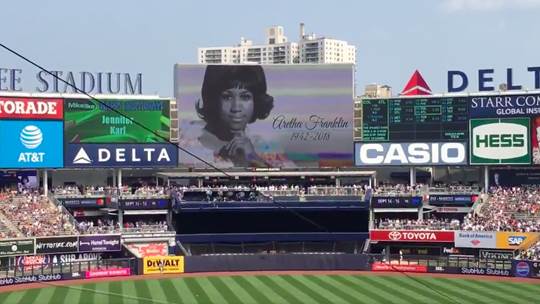This post is given the number “80” in honor of Mike Maloney and Hollis Hanover who both turned 80 this month. And yes, it also is the first post after Hot Stove #79, but don’t tell them. Fresh out of law school in the 1960’s, the three of us toiled together at the Popham firm. We now have a monthly lunch to reminisce (tell lies) about the good old days.
And speaking of the number 80, I need to admit that the previous three posts were numbered 77, 78 and 77. I did turn 77 this month, but that’s not why I used it twice. It was just a typo in the subject line for #79 (the one on Tim Sear’s rant). This is corrected in the online version. What, there’s an online version? Well yes, but it is a work in progress. My son Brian is working on a website to collect some of my posts (Hot Stove and otherwise). He is waiting on me for a home page narrative and other details, but here is a preview of coming attractions: https://lonniesjukebox.com/.
As for the next Hot Stove, it will come sometime after Labor Day Weekend – that’s when Rita and I will be attending our eighth straight Telluride Film Festival.
1991 Royals – Bret Saberhagen and Kirk Gibson: Hot Stove #73 told the story of Kirk Gibson’s move to the Dodgers in 1988 as a second-look free agent. After Gibson finished his 3-year deal with the Dodgers, he again became a free agent and signed a one-year deal with the Kansas City Royals. This triggered a memory for my partner Tim Sear (him again) who was in the stands when Gibson became a part of Royals lore.
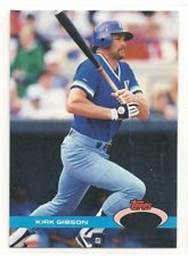
The date was August 26, 1991. Royals ace Bret Saberhagen was on the mound against the White Sox at Royals Stadium (not yet named Kauffman). In the fifth inning, Dan Pasqua of the Sox lifted a soft fly to left toward Kirk Gibson. It appeared that Gibson was tracking the ball, but it glanced off his glove and Pasqua ended up at second. The scoreboard flashed “Hit.” The first White Sox hit of the game. Or not. During the same inning, official scorer Del Black (a KC Star sportswriter) looked at replays and ruled that Gibson had committed an error.
I think Black made the right call – see the video here. It was certainly fortuitous for Saberhagen. He allowed no hits for the balance of the game to complete a NO-HITTER.

In a lucky bit of timing, I recently got to ask Del Black about the call. He and four other former writers from the Kansas City Star were at a book event that Steve Roling took me to a couple of weeks ago. Black and his fellow sportswriters were presenting the second printing of their excellent book From Worst to First: A History of Kansas City Major League Baseball 1955 to 1985. The photo below shows Steve getting his book signed by Sid Bordman. Standing behind Sid is Del Black and to Sid’s left is Bob Sands. The other authors were also at the event (Jim Murray and Joe Henderson). All are long retired, but Sid wins the seniority prize at 94.
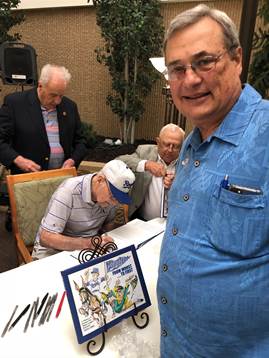
In the question and answer session, I asked Black about the Gibson error. Some reports had said Del first called it a hit and then changed his mind after reviewing the replays. But he said he never called it a hit – that was the act of the scoreboard operator. Black knew he needed a better look and so went to the replays and then made his only call on the play – the error. He also said that the call was mentioned in a Saberhagen baseball card, and I found a card online with this comment: “Pasqua thought he should have had a hit, but the official scorer ruled otherwise.” The card also said the Comiskey Park crowd of 25,164 gave Sabes a standing ovation at the end of the game. The attendance number is right, but the game was at Royals Stadium. As Tim Sear and Del Black will testify.

[Royals No-Hitter Trivia: There have been four no-hitters in Royals history. The others were by Steve Busby (who had two, 1973 and 1974) and Jim Colborn (1977). I cannot mention Colborn’s no-hitter without Mike White popping into my head. Mike was County Executive in 1977 and had a couple of tickets to the May 14 game. I was scheduled to go with him, but he got sick and cancelled, passing the tickets along to someone else. Colborn pitched his no-hitter that night. I have still not been in a stadium for a major league no-hitter. I told my sad Colborn story in an earlier Hot Stove post. Mike thinks I should get over it. My partner Jeb Bayer rubs it in by reminding me he was at the Colborn no-hit game.]
1992 Royals – TV: Some nostalgia – an ad for Channel 4’s coverage of the Royals in 1992. Click here.
1993 Royals – Manager Hal McRae: When Saberhagen pitched his no-hitter in 1991, the team was led by first-year manager Hal McRae. He had taken over earlier in the season after John Wathan was fired. McRae stayed on to manage the Royals through 1994, compiling a record of 286-277.
There were no doubt many good moments in McRae’s managerial tenure, but he may be best remembered for a not-so-good press conference on April 26, 1993. McRae was at his desk in his office surrounded by reporters after a Royals loss to Detroit. The tape recorders were laid out on his desk, and radio host John Doolittle asked “Did you consider Brett for Miller with the bases loaded in the seventh?”. The fuse was lit.
Rustin Dodd, former KC Star reporter now with The Athletic, wrote about this earlier this year. “What happened next is franchise lore, a beautiful maelstrom of flying telephones and tape recorders, of bleeps and bloodied reporters, of awkward silence and an opened vodka bottle…[A] flying object left a bloody 1½ inch gash on [reporter Alan] Eskew’s right cheek. It required a trip to the trainer’s room and a tetanus shot…most famous media injury in the history of the Royals.” It is unclear which thrown object caused the injury although the tape has been “replayed slowly, frame by frame, like a managerial Zapruder film.”
The tape is just over a minute, but the bleep rate is impressive. Click here.
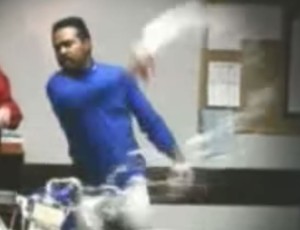
When you think about it, the reporter could have had it worse. Ask Willie Randolph. McRae was known for his old-style play and is remembered for his takeout slide of Randolph at second base in Game 2 of the 1977 ALCS. This allowed Patek to score and tie the game, but of course the Yankees came back to win the game. The Yankees also won the series. Damn Yankees.
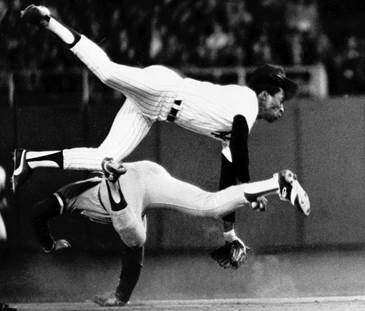
Kirk Gibson and Robert Redford – Walk-Off Homers: Three seasons before Kirk Gibson flubbed the catch in Kansas City, he was the toast of the country when he set aside serious injury and hit a walk-off homer in Game 1 of the 1988 World Series – igniting the Dodgers who went on to win the Series. Earlier this month, Robert Redford announced his retirement. Yes, there is a connection. Redford was an aging and ailing baseball player (Roy Hobbs) in the 1984 movie The Natural. He hit a dramatic walk-off pennant-winning homer. There is a fun video mash-up of the Gibson and Hobbs homers set to the Randy Newman music from the movie and the play-by-play from Vin Scully. Click here (3:12). Redford’s final movie, The Old Man & the Gun, will be released on September 28. Rita and I hope to get a sneak preview at Telluride.
Other Walk-Off Wins: One of my least favorite memories in Royals history came in the first year the franchise made it to the postseason – 1976. The ALCS was then a five-game series and the Royals and Yankees were tied at two games each. Trailing 6-3 in the 8th at Yankee Stadium, the Royals tied the game on a George Brett 3-run homer. In the bottom of the 9th with the game still tied 6-6, Chris Chambliss came up as the first Yankee batter. He hit Mark Litttell’s first pitch over the fence for a walk-off victory. Damn Yankees. If you can take it, here is Phil “Holy Cow” Rizzuto making the call and also describing the mayhem caused by the fans who charged the field and kept Chambliss from circling the bases (click here).
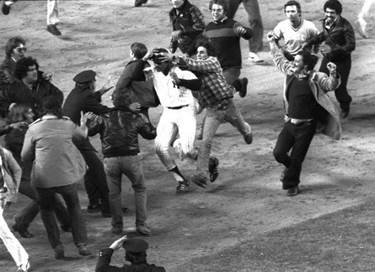
Walk-Off Grand Slam: This past Sunday night, I tuned in late to catch the end of the ESPN Sunday Night Game. The Nationals were leading the Cubs 3-0 at Wrigley Field. It was the bottom of the ninth, two on and two out. Ryan Madson was pitching for the Nationals (remember his stellar relief pitching for the Royals in the 2015 World Series?). The two men on base had reached on an infield hit and a hit-by-pitch. Madson then hit the next batter to fill the bases. The Cubs brought in pinch hitter David Bote, recently called up from the minors as an injury replacement. As you can guess from the title of this section, Bote blasted a grand slam for a walk-off 4-3 victory. Wrigley Field erupted. See it here (don’t miss his soft bat flip).

Walk-Off Bunt: On the other end of the spectrum, how about a walk-off bunt? Detroit’s John Hicks did that trick earlier this year. Very cool play (click here).
Walk-Off Strikeout: Hot Stove reader John Shipp sent me this gem from a recent minor league game. The Wisconsin Timber Rattlers were behind 6-4 in the last of the ninth against the Burlington Bees. The Rattlers loaded the bases, but there were two outs and batter Nic Pierre was behind on an 0-2 count. On the next pitch, Pierre flailed at a bad pitch and struck out, but the ball got away from the catcher. As a run crossed the plate, the catcher threw to get Pierre out at first. The throw was wild and the ball went to right field, allowing two more runners to score and give the Rattlers a 7-6 victory. Seriously, three runs scored on a strikeout. The players and the announcer could not believe what happened. See it here.
Cardinals Revenge: Within a week after my Don Denkinger post, the Cards came to town and swept the Royals. Three very easy wins. Karma?
Also in response to that post, Hot Stove reader and Cardinals fan Carl DiMaria sent this clever faux baseball card (in “1959 Topps style format”).
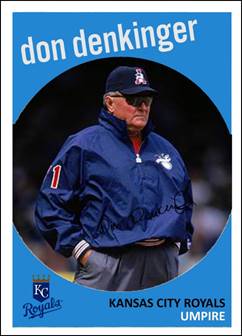
Whatever Happened to These KC Star Sportswriters?: You may have lost track of Rustin Dodd, Joe Posnanski, Jeff Passan and (almost) Lee Judge. Here’s an update:
Rustin Dodd – After life as a Royals beat reporter at the Star, Dodd moved this year to the national subscription-based website The Athletic. If you pay the $3/month, you get the nationwide coverage available on the site, but just Dodd’s Royals coverage is well worth the cost. His writing includes Royals nostalgia, such as his McRae article which is not bleeped like the video you saw earlier in this post.
Joe Posnanski – Joe still writes for the MLB website, but he has additionally set up his own subscription-based website. It has two tiers at $3 or you can get everything for $5/month. He is worth every penny. As always, Joe’s columns are incisive and funny and often branch out from baseball to movies, Hamilton and various offbeat subjects. He is also beginning two new series of Top 100 lists. He has two podcasts – the very funny “PosCast” with sitcom writer Michael Schur and a new series titled Passions in America. He has written several books, and if you have not read The Soul of Baseball about Buck O’Neil, you need to order it right now. Joe’s book on Houdini will be released in 2019.
Jeff Passan – Since leaving the Star in 2006, Jeff has been eloquently writing about baseball for Yahoo Sports. He also wrote a best-selling baseball book in 2016, The Arm: Inside the Billion-Dollar Mystery of the Most Valuable Commodity in Sports.
Lee Judge – After retiring from the Star last year, Lee relied on his own website to continue his “Judging the Royals” column. The good news is that the Star has again picked up his column, and you can find it online and sometimes in the print edition. Lee’s columns break down the behind-the-scenes details of baseball, expanding and updating the book he wrote with former catcher Jason Kendall, Throwback: A Big League Catcher Tells How the Game is Played.
In all cases, if you follow them on Twitter, they post a link when they have new columns.
Lonnie’s Jukebox – Kauffman Stadium Walk-Out Music: I am mostly the cranky old guy about the loud music at Kauffman, but I do like the choices at the end of the games. If the Royals lose, you hear Wilbert Harrison’s “Kansas City.” If they win, it’s the Beatles’ cover of the same song. The two versions are very different. Here’s why.
The song was written by the famous duo of Jerry Leiber (who died in 2011) and Mike Stoller. Earlier this summer, the two songwriters were honored with a medallion on the American Jazz Museum Walk of Fame in the 18th and Vine District. Mike Stoller was on hand for the unveiling, shown below with Congressman Emanuel Cleaver, the medallions at their feet. The songwriters were also in the news this past May when the song they wrote with Ben E. King was sung at the Royal Wedding (“Stand By Me”).
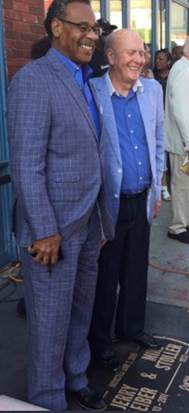
Teenagers Leiber and Stoller wrote “Kansas City” in 1952 for R&B singer Little Willie Littlefield. The record was released as “K.C. Lovin’” because the record label preferred that title. Leiber and Stoller did not. The record had some minor regional success, but did not make the national charts.
In the fall of 1955, Little Richard went into the recording studio and cut two versions of “Kansas City” – one similar to Littlefield’s and one with an added raucous refrain of “Hey-Hey-Hey-Hey.” The Littlefield cover later became part of a 1970 album and was never released as a single. The “Hey-Hey” version was also not immediately released, but it leads to a better story.
In 1958, Little Richard had a hit with “Good Golly, Miss Molly.” I was a junior in high school and a big Little Richard fan (he had me at “Tutti Frutti”). I bought and still have my copy of “Good Golly, Miss Molly,” but the relevance for this story is that the flip side is “Hey-Hey-Hey-Hey.” Little Richard had lifted his “Hey-Hey” refrain from “Kansas City” and expanded it to a full song.

In April of 1959, Little Richard finally released the single of his “Hey-Hey” version of “Kansas City.” But he had waited too long. That same month, Wilbert Harrison released his cover of the song with its fabulous shuffle beat. Little Richard’s version peaked at #95 while Harrison’s record shot to #1 for two weeks, overlapping my last two weeks of high school. I also still have this record.
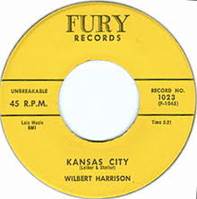
The Beatles cover of “Kansas City” was not released until December 4, 1964, as part of the album Beatles for Sale. But the story of their version of the song starts two years earlier. In 1962, the Beatles performed twice with Little Richard in England and then became friends with him during a two-week stint at Hamburg’s Star-Club. They saw Little Richard do his unique “Hey-Hey” version of “Kansas City” and adopted it for their own set. Per Paul McCartney, “I could do Little Richard’s voice, which is a wild, hoarse, screaming thing; it’s like an out-of-body experience. You have to leave your current sensibilities and go out a foot above your head to sing it.”
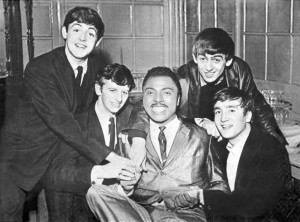
The Beatles mostly dropped the song from their set by 1963, and it was not on the set list for their first American tour in 1964. But when they appeared at Kansas City’s Municipal Stadium on September 17, 1964, it was only natural to sing the song. It was so “rapturously” received by the crowd (which included 14-year old Rita Leifhelm), that the band decided to record the song. It was done in one take as part of a mammoth recording session on October 18, 1964. Although the early releases of the record, including the single in 1965, only showed Leiber and Stoller as the writers of the song. This was later changed to add R. Penniman (Little Richard) to credit his “Hey-Hey” addition.
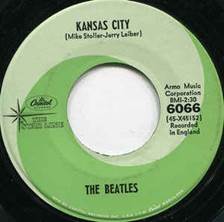
So for your listening pleasure, here are all four versions: Little Willie Littlefield, Wilbert Harrison, Little Richard and the Beatles. The Beatles video does not show them singing in KC, but the montage has memorabilia from the KC concert.
I love the fact that the Beatles sang “Kansas City” in a live performance at old Municipal Stadium and now some 54 years later their song has survived to be the walk-out music for victories at Kauffman Stadium:
The good news: In 2015, fans exiting the K heard the Beatles 51 times and Wilbert Harrison 30 times, reflecting a home field record of 51 wins and 30 losses. Then on to a World Series.
The bad news: This year to date, the Kauffman fans have heard the Harrison version 44 times, the Beatles 18 (not a typo). The current home record is 18-44! No World Series on the horizon.
Back to good news: We’ll always have 1985 and 2015.
Now for Some R-E-S-P-E-C-T: For the late Aretha Franklin. The only time Rita and I saw a live performance by Aretha was in 2009. Crowned by a memorable bow-shaped hat, she sang “My Country, ‘Tis of Thee” at the inauguration of President Barack Obama. It was mesmerizing.
One of our favorite Aretha moments was her tribute to Carole King at the 2015 Kennedy Center Honors. This video is wonderful on all levels: the introduction by Chilina Kennedy who currently portrays Carole King in the hit Broadway show Beautiful; Aretha’s entrance and her belting out Carole’s “(You Make Me Feel Like) A Natural Woman.”; Carole King’s response from her balcony seat; and the reaction from the Obamas and the rest of the audience. Quite a special evening.
And from Yankee Stadium yesterday:
